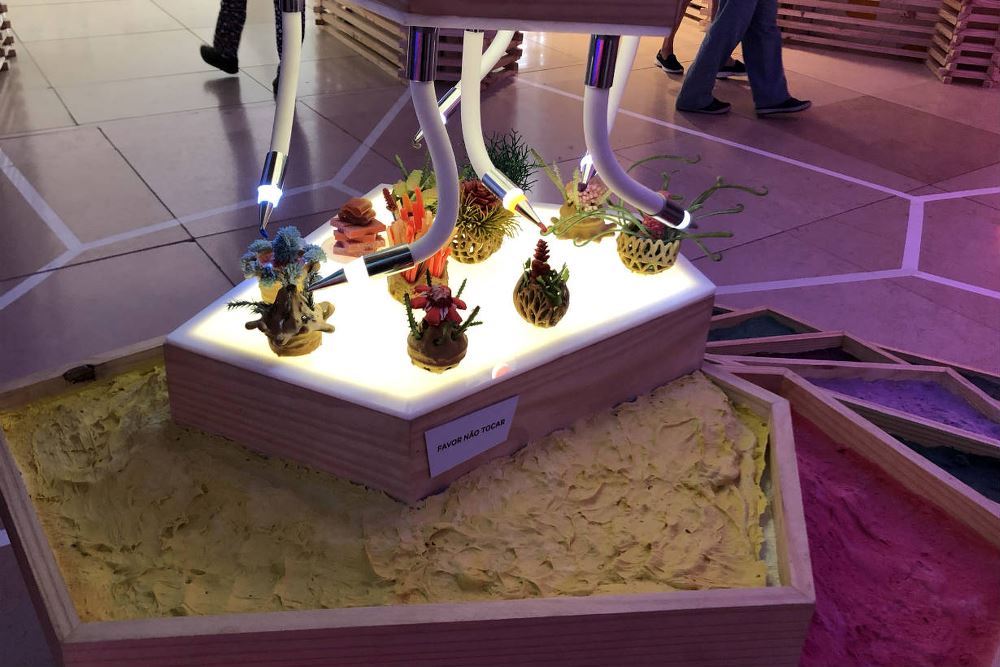
Would you like to print your own food?
Would you rather pull a carrot out of the ground or create your own model and press print?
By future scientist Anne-Marie Dahl, Futuria, Denmark
Would you like to print your own food? Self-printed food will improve and can become much more important in the future. That is what they believe at the Future Museum in Rio de Janeiro, Brazil, where a displayed food printer shows what we have to expect in terms of Future Foods. In the innovative laboratory "backstage", an interdisciplinary team works to develop healthy, sustainable and even aesthetic prototypes of products based on algae and fungi. Products that you adjust to your culinary taste right now and then and then press print.
The future museum has sustainability as its main focus and tries through a thought-provoking exhibition of yesterday, today and tomorrow to make it understandable what consequences our "more, more, more" lives can have for our planet and our future. The main focus is the development of new innovative and sustainable solutions with concrete ideas in relation to working life, housing and food culture, and the thoughts about our personal food printer are particularly fascinating. And it is in line with many of the most important megatrends such as individualization, digitization, performance and emotional experiences.
It must be a dream for any individualist to print his own food according to his wishes and needs. The food can be tailored precisely to your need for vitamins, medication and fat percentages and therefore it is both easy and healthy for you. And you can get rid of lactose, sugar and gluten or whatever is “hip” to avoid right now. Based on algae and mushrooms, the food is also climate conscious - no nasty cows here, though you can certainly print something that looks like and tastes like a real red steak. The great prototypes at the museum testify that you can also experience being your own chef creating eye-catching dishes. There is plenty of experience economy in your new food printer. It's High Tech, it's sustainable and helps you in your stressful everyday life. What's not to like?
Just because something is possible, we may not do it, is a good lesson when we look at digital trends. It is not enough to find a food printer, the deciding factor is whether we will accept new technologies. If in the future it is possible to transform sewage into drinking water, would we be willing to drink it?
Another example of sustainable food production we find about 1 hours flight from Rio De Janeiro in Paraty. Here, you have brought nature back to its original balance and created a prototype on an agro forest farm. Hand power and bio balances are the answer to future food production. All herbs, plants and trees are planted so they balance each other and can grow without the use of artificial chemistry. The production form is about 40-50% more expensive than traditional agriculture, but on the other hand it is completely in agreement with nature. Contrary to the distance of the food printer, there is a direct view of nature and many Brazilian schoolchildren come to see and experience that a carrot actually comes from the ground and cocoa milk does not come from a brown cow. It's about living in and with nature and leaving the earth also to future generations.
Two examples on widely different scenarios for future food production in the light of sustainability. Which of the two is most realistic? Which trend will be strongest? When working with future science, you always leave the door of doubt open. We can point out megatrends and contradictions and discuss how they will coincide, but only the future will show what we have chosen; a back to nature scenery or the more artificial world of the printer model. Would you rather pull a carrot out of the ground or create your own model and press print?
Nyhedsbrev
Vil du vide mere om fremtiden? Tilmeld dig nyhedsbrevet fra fremtiden med artikler og analyser om, hvordan megatrends påvirker os som mennesker, information om foredrag og meget andet. Nyhedsbrevet udkommer ca. 10-12 gange årligt.









Følg mig her: